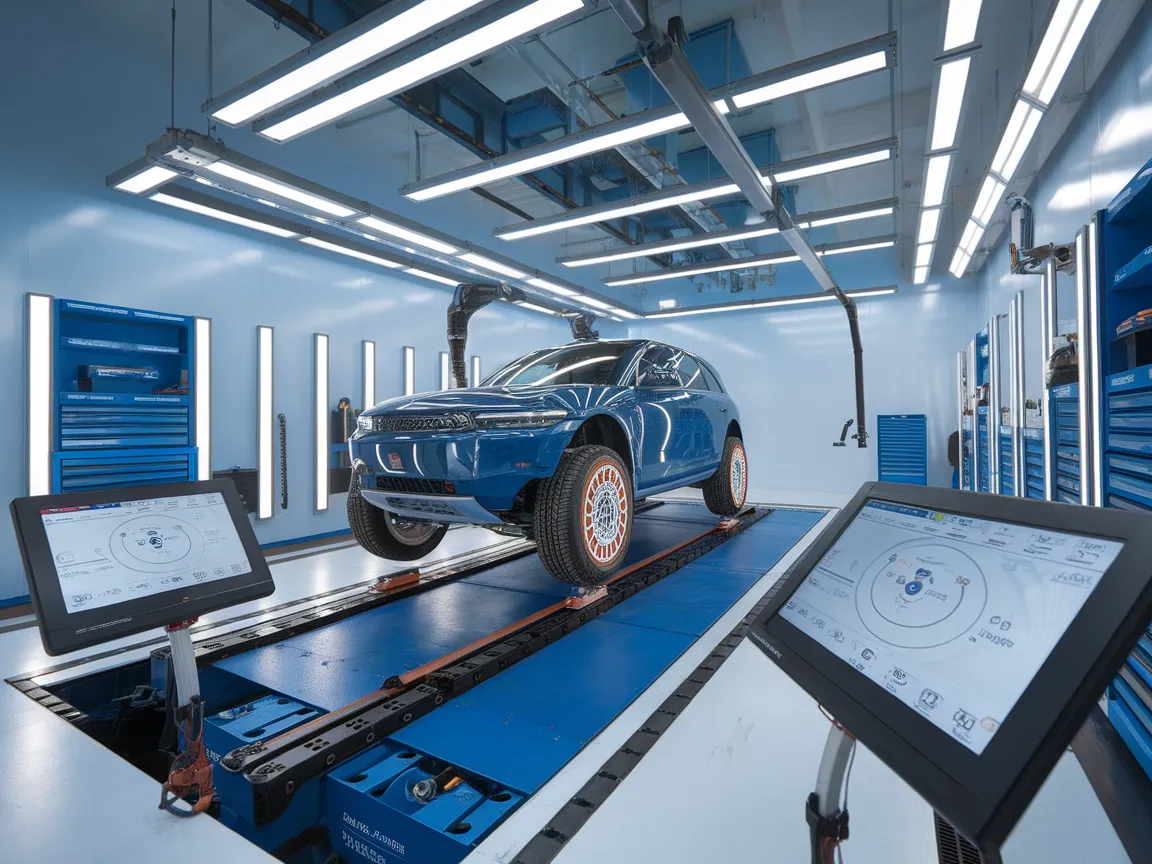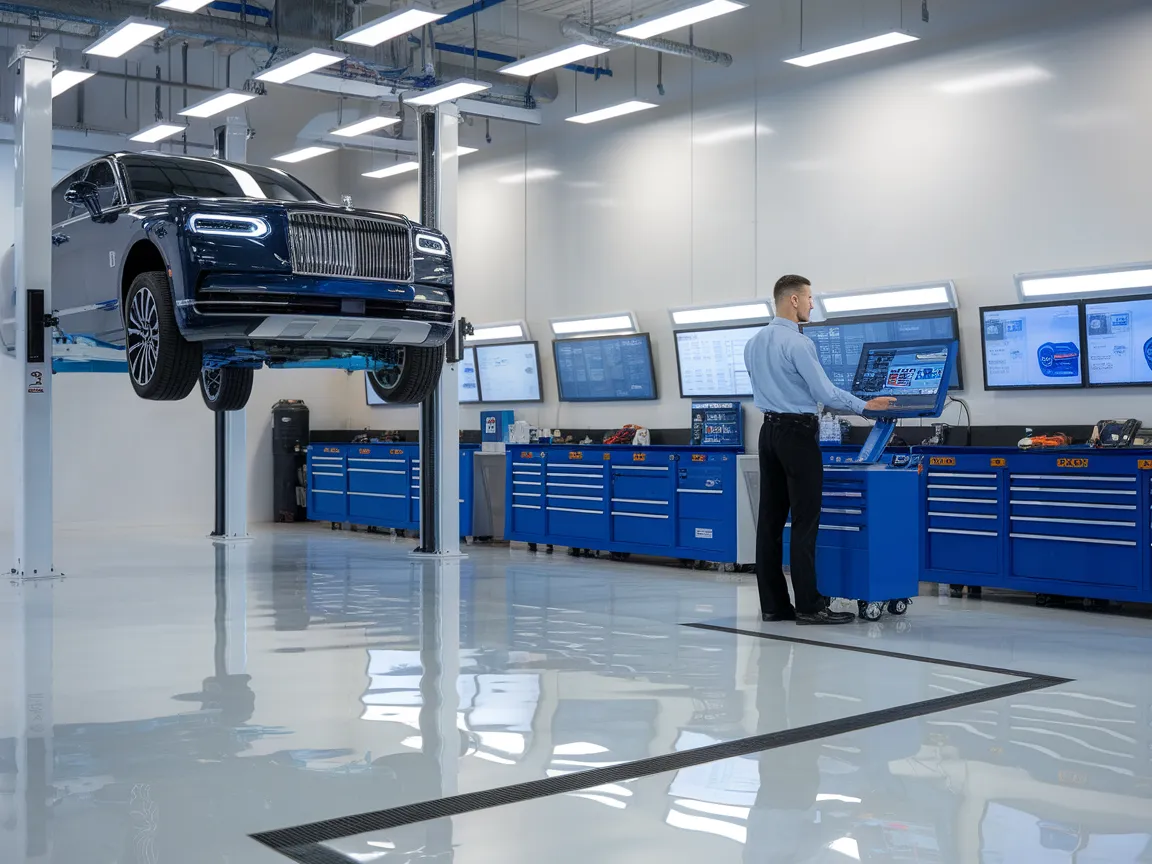To guarantee your vehicle performs safely and efficiently, it's essential to get general mechanical maintenance. Commence with basic maintenance such as fluid level checks and monitoring tire inflation. Be sure to change your oil every 5,000 to 8,000 miles and keep track of brake fluid status. Familiarize yourself with critical powertrain components to spot potential issues early on. Don't forget to examine the brake assembly and suspension for wear and tear. Utilize digital applications for maintenance tracking and troubleshooting to avoid unexpected issues. Choose professional technicians with ASE-certified staff and modern diagnostic gear for reliable repairs. Looking ahead, exploring advanced repair technologies might be your next step.
Essential Points
- Regular service, such as oil changes and tire pressure maintenance, plays a vital role for vehicle longevity and optimal operation.
- Periodic brake system inspections and fluid replacements safeguard safe operation and minimize serious problems.
- Knowledge of engine components and frequent concerns helps in proactive auto care.
- ASE-certified mechanics offer skilled maintenance confidence for auto repairs and upkeep.
- Electrical system analysis identify operational problems and need expert knowledge for complicated issues.
Fundamental Vehicle Service and Maintenance Solutions
When it comes to vital auto service and maintenance, grasping scheduled maintenance plans is crucial to ensuring your vehicle running smoothly. By maintaining a preventative maintenance plan, you'll guarantee long-term vehicle operation and dependability.
Begin with regular vehicle examinations and regular checks of fluid status and tire conditions. These fundamental tasks can avoid larger issues in the future. Don't forget to check the brake system and schedule oil changes at the specified intervals. Moreover, replace filters and inspect belts and hoses to prevent unexpected breakdowns.
Utilize digital maintenance management to improve your efforts. Automated service reminders and digital maintenance records keep you track your vehicle's needs.
Instant diagnostics and custom maintenance intervals enable precise scheduling, improving your vehicle's lifespan. Service job management confirms nothing is overlooked, offering assurance.
Understanding Your Vehicle's Core Components
To effectively maintain your vehicle, you need to understand its key mechanical systems and their common issues.
Familiarize yourself with the workings of engine parts, essential principles of powertrain systems, and the importance of regular brake system maintenance.
Furthermore, understanding steering and suspension mechanics, along with electronic system analysis, will help you prevent issues before they arise.
Engine Components and Common Issues
Understanding your vehicle's mechanical systems is essential for maintaining ideal performance and preventing costly repairs. Let's focus on essential engine elements and frequent concerns.

The engine block functions as the core component that contains the cylinders where the combustion process takes place. The cylinders' pistons change fuel energy to mechanical energy. The crankshaft then converts this vertical motion into rotational force, propelling your vehicle.
The valvetrain plays an important role in controlling the timing of fuel and air mixture and regulating exhaust gas release. This incorporates a intricate network of camshafts, valves, and springs, maintaining efficient engine operation.
Common engine problems can present themselves in different forms. Starting issues often point to electrical or fuel delivery problems—examine the starter motor, fuel pump, and battery.
Operating problems like irregular operation or misfires may be caused by worn spark plugs, clogged fuel injectors, or damaged oxygen sensors.
Overheating is another frequent concern, typically caused by failing water pumps, coolant leaks, or malfunctioning thermostats. Be vigilant for indicators like abnormal sounds or physical signs such as unusual exhaust fumes.
Scheduled upkeep, including proper oil and air filter maintenance, is essential for preventing these issues.
Understanding Transmission and Drivetrain
Mastering the fundamentals of your vehicle's transmission and drivetrain is crucial to guaranteeing efficient power delivery and total performance. The powertrain, comprising both engine and drivetrain, transforms the engine's energy into managed movement.
Fundamental to this system, the transmission controls power delivery, adjusting two primary types: manual, demanding clutch and gear input, and automatic, which independently handles gear changes via hydraulic systems.
When working with automatic transmissions, the torque converter serves a crucial role by connecting the engine to the transmission. It boosts torque output through hydraulic multiplication, ensuring energy is transferred effectively.
The driveshaft, made from durable materials like aluminum or steel, transmits rotational force from the transmission to the differential, featuring constant-velocity joints for efficient operation.
Understanding the differential is essential; it permits wheels to rotate at different speeds during turns, sustaining power delivery, specifically in vehicles with multiple driven wheels.
Axles connect the wheels to the differential, varying in configuration based on vehicle design.
To ensure optimal performance, periodic upkeep and checking of these components are vital, boosting fuel efficiency and avoiding costly repairs.
Understanding Brake Maintenance
Understanding the intricate world of brake system maintenance guarantees both safety and performance on the road. Your vehicle's brake system is an intricate collection of parts including brake pads, rotors, calipers, brake lines, and fluid. Each component needs careful monitoring for optimal functionality.

Regular inspections, optimally carried out yearly or more frequently according to your driving conditions, are crucial for catching problems before they escalate.
Brake fluid maintenance is essential since it absorbs moisture, leading to reduced efficiency and corrosion. Change it every 24-36 months or 30,000 miles. Likewise, monitor brake pads—they deteriorate naturally and typically require changing between 25K and 70K miles.
Be alert to warning signs like unusual noises—such as squealing, grinding, or metal-on-metal sounds—and symptoms including a spongy brake pedal, vehicle pulling to one side, pedal vibrations, or increased stopping distances. These indicators warrant prompt service from a certified technician.
Routine upkeep consists of monthly brake fluid monitoring and pad thickness evaluations. Moreover, maintain smooth braking techniques and refrain from riding the brakes.
Suspension and Steering Components
Navigating the complex components of suspension and steering is essential for maintaining your vehicle's reliability and handling. Your suspension system utilizes multiple springs—including coil, leaf, torsion bars, and air—to carry the vehicle's weight and absorb impacts.
Dampening elements including shock absorbers, struts, control arms, and bushings regulate wheel travel and decrease vibration. Collectively, these parts stabilize your ride, enhancing handling and comfort.
In steering, key components comprise the column, steering wheel, tie rods, rack and pinion, and ball joints. Power assist systems—whether hybrid, hydraulic, or electric—provide necessary assistance, making steering smoother and more accurate.
Spotting signs of issues is vital. If you notice excessive bouncing, uneven tire wear, or difficulty steering, these could point to suspension or steering concerns.
Periodic inspections are essential. Check shock absorbers, bushings, and power steering fluid levels periodically. Resolve any vehicle pulling or unusual noises without delay.
Periodic alignment checks and maintenance of moving parts can prevent long-term damage. By knowing and servicing these systems, you guarantee predictable braking, consistent road contact, and a smoother driving experience, finally boosting your vehicle's overall safety and performance.
Electrical System Diagnostics
Delving into the fundamental aspects of your vehicle's electrical system is crucial in ensuring maximum efficiency and dependability. Modern vehicles depend on these systems for everything from core systems to auxiliary functions, making diagnostics a fundamental requirement.
Begin by gathering the essential tools: a digital multimeter for analyzing circuit values; diagnostic scan tools for decoding error messages; and waveform analyzers for analyzing electrical waveforms.
Begin diagnostics by documenting symptoms and visually inspecting components for signs of damage or corrosion. An organized evaluation initiates with a battery health check, proceeding to charging system verification and ground connection verification.
Fuse and relay checks are important to pinpoint any power flow interruptions. Frequent problems often involve the ignition system, such as battery troubles or starter motor failures, and power generation issues like alternator and voltage regulation problems.
Sophisticated methods, like waveform interpretation and current drain analysis, help solve complex issues. For computer system diagnostics, validate ECU communication and sensor integrity are intact.
Regular upkeep, including battery terminal cleaning and cable condition assessment, is crucial. Consult qualified technicians for challenging technical issues, documenting repairs to track recurring issues and verify proper repairs.
Choosing a Reliable Auto Repair Facility
When looking for a professional auto repair service center, make sure to focus on businesses with ASE-accredited mechanics to ensure you receive expert repairs.
Remember to review repair guarantee information to get clarity on what coverage comes with the work.
Be sure to compare their equipment and technology, along with pricing structure and customer service quality, to determine the ideal choice for your automotive needs.
Understanding ASE Certification
Finding a professional auto repair shop may seem daunting, but being familiar with ASE certification helps streamline the process. ASE certification, issued by the National Institute for Automotive Service Excellence, is the automotive industry's benchmark for professional competence.
As you search for an auto shop, look for the distinctive blue seal and technicians displaying ASE patches. These indicators demonstrate that the technicians have met demanding standards through comprehensive testing in particular areas such as brake systems, engine work, and electrical components.
Technicians obtain ASE certification by fulfilling two years of practical experience or pairing one year of experience with a two-year automotive degree, before passing focused exams. To maintain certification, they must renew their credentials every five years, guaranteeing they remain current on the latest automotive technology.
This devotion to continuous education assures that certified technicians are qualified to competently diagnose and repair modern vehicles' advanced systems.
Master ASE Certification goes beyond, demanding technicians to succeed in multiple tests across various specialties, showing their complete expertise.
Warranty Service Details
Navigating the details of service warranties is crucial when selecting a professional auto repair shop. It's important to understand the categories of warranties—factory and extended—to make sure your vehicle receives the right coverage.
Factory warranties, included with new vehicles, typically offer comprehensive vehicle and drivetrain protection for specific periods. Meanwhile, extended warranties offer optional protection after factory terms and can be tailored to feature benefits like emergency support.
When reviewing a warranty provider, look for those with BBB accreditation, direct payment options to repair shops, and flexible repair facility choices. Confirm they offer clear terms and upfront pricing, which will protect you against unexpected costs.
It's crucial to understand what's covered and excluded—system malfunctions and electrical issues are generally covered, while regular service and typical wear are not.
To get the most from your warranty benefits, preserve detailed service records and comply with the manufacturer's maintenance schedule. This guarantees smooth claims processing and prevents disputes.
As you select a repair shop, look for one that offers comprehensive warranty options, keeps clear documentation, and provides clear updates, ensuring your vehicle is in capable hands.
Equipment and Technology Standards
When selecting a qualified auto repair shop, it's crucial to consider equipment and technology standards, guaranteeing your vehicle obtains superior care.
You should confirm basic safety gear, comprising protective wear and fire safety systems. These items protect both technicians and your car.
Evaluate sturdy vehicle lifting equipment, like hydraulic lifts and motor lifts, which are crucial for efficient and reliable repairs.
Examine their diagnostic technology. Contemporary shops should employ OBD scanners, electronic inspection systems, and alignment diagnostic tools to properly assess vehicle issues.
Advanced service tools including fluid handling equipment and precision tools like brake machining tools and tire changers are critical for comprehensive services.
Confirm digital system integration with shop management systems that optimize workflows, inventory, and customer communications. This ensures effectiveness and transparency.
Service standards are essential; the shop should maintain equipment care standards, comprising regular calibrations and safety checks, fulfilling industry standards and safety regulations.
Cost Comparison Techniques
Navigating the intricacies of auto repair costs requires a methodical approach to confirm you're getting the best value for your money. Start with conducting an thorough assessment of your vehicle's details and current concerns. This guarantees you receive precise quotes. Record all problems, warning signals, and unusual sounds; this documentation helps mechanics to provide accurate estimates and eliminates unnecessary diagnostic fees.
After preparation, gather at least three estimates from reliable shops. Evaluating quotes helps you identify both excessive charges and questionably cheap quotes that could suggest inferior repairs. Examine parts quality, labor costs, warranty coverage, and included additional services. Look for variations in diagnostic fees and service itemizations.
Standards are essential, so evaluate each shop's credibility by checking feedback, confirming certifications, and observing cleanliness. Consider parts quality, whether OEM, aftermarket, or rebuilt, as this influences reliability.
Lastly, evaluate extra perks like guarantees, complimentary checks, or loaner cars. When choosing, analyze total costs, including long-term reliability and convenience. Look into price matching and service bundling opportunities for better value.
This detailed approach guarantees you choose a shop offering reliable repairs at a fair price.
Professional Service Criteria
When evaluating a qualified auto repair shop, focusing on excellent customer service standards is crucial to ensuring a positive and trustworthy experience.
Start by assessing their client interaction. A premium shop will break down complex repairs into clear explanations, avoiding technical jargon that could confuse you. They must also be honest about pricing, offering detailed estimates before work begins and notifying you of any extra services required.
Evaluate their professional standards by looking for consistent service quality and technical expertise. Licensed professionals must be employed, continuously improving their skills to handle modern vehicles. This ensures correct troubleshooting and excellent service, complying with manufacturer specifications.
Evaluate the customer experience as well. A reputable shop maintains clean, organized facilities with pleasant waiting rooms, reflecting dedication and professionalism to service. Complete records of repair documentation, estimates, and repair authorizations must be on hand, fostering reliability.
Quality service encompasses maintenance guidance and follow-up services to resolve any subsequent questions.
Choosing Between DIY or Professional Vehicle Repairs
Deciding between perform auto repairs yourself or consult a professional is an important decision that influences both your finances and the lifespan of your vehicle.
Regarding simple tasks like oil changes, tire rotations, and air filter replacements, DIY is often a practical choice. These tasks call for basic tools such as standard automotive tools and equipment.
However, safety is paramount; make sure to utilize proper vehicle support equipment and never work under a car supported only by jacks.
On the other hand, advanced major mechanical work and critical systems should be left to professionals. Experts have the advantage of specialized equipment and factory training, making certain the job is done right.
They give access to factory documentation and quality assurance guarantees, which are essential for maintaining your vehicle's integrity.
Consider the cost-benefit analysis: while DIY repairs save on labor costs and allow for schedule flexibility, professional services provide advanced diagnostics and warranty coverage.
When uncertain about your ability to properly and securely complete a repair, contacting a professional mechanic is recommended.
Your decision should balance technical knowledge, safety concerns, and available tools to maintain peak vehicle performance.
DIY Auto Repair Learning Resources
As you weigh the choice between DIY and professional auto repairs, being aware of the available resources for training and assistance can tip the balance.
YouTube serves as a valuable repository of visual tutorials, with educators like ChrisFix and Eric The Car Guy delivering comprehensive tutorials on topics ranging from simple oil changes to complex engine repairs. These resources are essential whether you're just starting.
Discussion boards including Reddit's MechanicAdvice and the CarTalk Community allow you to access an abundance of collective wisdom. You can seek advice, troubleshoot issues, and contribute knowledge with other DIYers and experts.
These communities specialize in solving specific repair problems through community support.
Access to professional repair manuals is essential for exactness. Guides like Chilton and Haynes offer detailed, model-specific documentation that confirm you're following proper procedures.
ALLDATAdiy offers updated technical service bulletins and OEM specifications, boosting repair precision.
For structured learning, platforms featuring ASE Certification prep and manufacturer-specific training programs can improve your technical expertise.
Integrate these with digital parts identification tools like AutoZone's parts finder for a comprehensive repair journey, guaranteeing you have the right components for each repair.
Successful Communication with Automotive Professionals
Proper communication with auto repair professionals is crucial to ensure you receive accurate and effective service. Commence by understanding basic automotive vocabulary. Comprehending terms related to engine components like engine parts, and mechanical systems such as mechanical assemblies, helps you discuss issues effectively. Understanding the meanings of warning lights is also essential.
When detailing problems, be specific and exact. Record when and where the problem occurs, including exact conditions like driving conditions. Document abnormal noises, odors, or movements. Utilize directional indicators, detail problems without diagnosing, and note the timing and frequency of issues.
Record-keeping plays an crucial role in securing smooth service. Maintain records of your vehicle's upkeep documentation, past work, and service intervals. Make sure you have formal consent, itemized quotes, and component guarantees.
Don't hesitate to seek clarification. During the preliminary meeting, discuss service duration, expense itemization, and component specifications. Request status reports and new discoveries during the service.
This preventive approach not only explains the process but also aids in comprehending maintenance advice. By adhering to these principles, you'll foster effective communication and optimize service outcomes.
Financial Planning for Repairs
Understanding the intricacies of maintenance expenses is equally crucial to communicating effectively with automotive experts. Begin by implementing a bottom-up estimation, analyzing individual repair aspects, evaluating parts, labor, overhead, and diagnostic time. This methodical approach confirms you address all expenses.
Alternatively, utilize a triple-estimate approach, projecting optimistic, pessimistic, and realistic scenarios to compute a weighted projection. This strategy offers a thorough view of potential expenses.
Research insurance alternatives to regulate spending. Standard coverage like collision and extensive policies can mitigate surprise charges, while extended protection plans provide additional security through manufacturer warranties or external insurance options.
Evaluate these options against your maintenance requirements and deductible requirements.
Explore financing options and payment methods to control service costs productively. Conventional funding options, like financial loans or credit options, delivers adaptability, while other options such as buy-now-pay-later services or critical service savings offer further choices.
Proactive Service Practices
Your vehicle's longevity can be greatly increased through a strategic preventive maintenance strategy.
Implement scheduled service intervals at 5,000-8,000 mile intervals or about every six months. Basic maintenance covers changing oils and filters, checking fluid levels, wheel position changes, and basic inspections.
Every 15,000 miles, carry out intermediate services with complete car examinations and refresh transmission fluid and air filters. Upon reaching 30,000 miles, perform major services like spark plug and brake fluid replacement, along with replacing differential oil and cabin filters.
Regular fluid upkeep is vital. Periodically refresh engine oil every 5,000 to 8,000 miles.
Replace transmission fluid every 30,000 miles to prevent wear. Refresh brake fluid at two-year or 25,000-mile intervals, and refresh cooling fluid every 30,000 miles or two years to maintain proper temperature.
Follow filter replacement guidelines: Engine air filters every 15,000 miles and replace cabin filters at 30,000-mile intervals.
Replace oil filters with every oil change.
For tire maintenance, perform tire rotation between 5,000 and 8,000 miles, check alignment annually, and monitor tire pressure monthly.
Periodically examine battery connections for oxidation, track battery health, and ensure terminal cleanliness to maintain consistent function.
Critical Car Repair Assistance
Although regular servicing maintains your vehicle in optimal performance, unexpected breakdowns can still arise. This is where emergency auto repair solutions are crucial. With 24/7 service availability, you're consistently supported. This encompasses full holiday and weekend support, guaranteeing assistance at any time.
A dedicated crisis line provides instant communication, and with multi-language support, it's accessible to foreign motorists. Coverage networks cover both urban and rural zones, providing highway and interstate support. Cross-country help is available, with swift response assurance providing quick assistance.
Basic roadside help encompasses jump-start service, flat tire replacement, urgent fuel service, lock solutions, and initial mechanical checks. Safety protocols like safe vehicle placement and warning signal setup maintain your safety while waiting.
Vehicle recovery services features professional towing options, supporting even heavy-duty vehicles. Professional handling and safe transport avoid further damage.
Temporary transportation solutions provide rental vehicles, transportation arrangements, and transfer options. Furthermore, accommodation support can organize temporary lodging during repairs and provide vehicle storage solutions.
In crisis situations, these thorough solutions assure you're back on the road securely and promptly, limiting interruption and protecting peace of mind.
Modern Automotive Maintenance Solutions
You can streamline your auto care by leveraging modern automotive maintenance systems.
Web-based maintenance planning and digital vehicle history records keep your service needs organized and easy to retrieve.
Using remote diagnostic services and vehicle care applications, you remain alerted and aware of scheduled maintenance needs, providing timely and efficient car service management.
Online Appointment Scheduling
Modern automotive service solutions revolutionizes how service centers and clients manage appointment scheduling. Transitioning to digital scheduling systems, you can book appointments anytime via online platforms, accessing real-time calendar availability. This assures you select the most convenient time for your service.
With options to select specific services, featuring in-depth information, you're informed at each stage.
Digital booking systems enhances customer management by digitalizing scheduling confirmations and tracking automotive data, preventing booking mistakes. It synchronizes calendars across platforms, allowing smooth personnel coordination, work assignment, and facility utilization. This efficiency ensures service time is effectively managed, minimizing wait times.
For auto repair shops, online booking decreases telephone distractions, streamlines appointment organization, and optimizes resource allocation through digital notification tools. This not only enhances operational efficiency but also enhances your experience by providing autonomous scheduling, systematic notifications, and easy rescheduling if necessary.
Digital Vehicle History Records
In the evolving landscape of automotive maintenance, digital record-keeping systems are changing how service information is managed and accessed. By upgrading from traditional paper logbooks with secure electronic documentation, you gain full visibility of your vehicle's service documentation with ease. This unified system captures all repairs, maintenance, and service tasks with precise timestamps, guaranteeing a traceable and reliable history that accompanies your vehicle throughout its lifetime.
You'll find that digital service records deliver improved visibility, letting you view online your vehicle's comprehensive service documentation. This builds trust between you and your service provider.
Additionally, the precision of digital systems removes manual entry errors, delivering a standardized documentation format that guarantees consistent record-keeping across different service providers.
For future planning, digital records help you track and schedule maintenance needs, ensuring timely service intervals and preventing missed opportunities. As a result, your vehicle's resale value can notably benefit from a well-documented history, providing proof of proper maintenance.
Whether through proprietary platforms such as Mercedes-Benz DSB or through certified repair facilities with manufacturer-approved systems, you're promised thorough documentation, regardless of where service is performed.
This transition to digitization delivers enhanced information protection and improved compatibility with modern vehicle technology.
Connected Car Diagnostics
Expanding from the groundwork of digital vehicle history records, remote diagnostic services elevate automotive maintenance to the next level by utilizing IoT and connected technologies. With these solutions, you can track and identify vehicle issues without a physical inspection. Through OBD systems and IoT sensors, your vehicle sends real-time data about its system health, key parameters, and potential issues.
Key components include devices like monitoring systems, IoT sensors, telematics systems for data transmission, and edge computing devices. Technical solutions support these with continuous observation tools, problem identification systems, preventive analysis systems, and fleet management interfaces.
The primary features are real-time monitoring and proactive upkeep. You'll benefit from ongoing system monitoring, performance data collection, vehicle condition evaluation, and immediate alert generation. Proactive care enables prompt problem identification, performance pattern analysis, and upkeep planning enhancement to forecast component failures.
For auto repair shops, these capabilities optimize diagnostic accuracy, minimize inspection time, improve service scheduling, and aid in better resource allocation.
As a vehicle owner, you'll experience minimized unexpected breakdowns, reduced maintenance costs, flexible maintenance booking, and straightforward service operations. Implement this innovative approach to guarantee your vehicle's performance and dependability.
Service Reminder Systems
Automotive service reminder systems modernize vehicle maintenance by streamlining service alerts and appointments, ensuring you always remember an important service appointment. These sophisticated tools eliminate the need for conventional systems like manual reminders and calendars, offering adjustable service intervals based on mileage or time. You'll receive prompt notifications via email, SMS, or app alerts, continuously updating service cycles to ensure peak automotive efficiency.
Service reminder systems also specialize in data management. They track comprehensive car data, track maintenance history, and track repair expenditures with electronic documentation. This organized approach contributes to decreasing scheduling conflicts and streamlining workflow management, boosting customer communication and retention.
For you, as a vehicle owner, these systems deliver enhanced vehicle care. They provide punctual maintenance alerts and monitor preventive maintenance, recording your vehicle's service history and offering workshop location information. This preventive strategy extends your vehicle's lifespan, decreases breakdown risks, and diminishes long-term maintenance costs while ensuring safety compliance.
When implementing these systems, evaluate features like multiple vehicle monitoring, personalized alerts, and effortless compatibility with existing systems.
Emphasize user experience with user-friendly controls, easy appointment scheduling, and well-defined reminders to access your service history effortlessly.
Mobile Apps for Maintenance Tracking
Maintenance tracking platforms have revolutionized your approach to vehicle maintenance, but mobile apps for maintenance tracking provide even greater convenience by putting a thorough digital service management tool right in your pocket.
With platforms such as CARFAX Car Care, you can manage up to eight vehicles simultaneously, receive personalized maintenance schedules aligned with your vehicle's specifications, and get alerts about safety recalls.
Drivvo enables you to track vehicle expenses and upkeep costs with in-depth graphs, supporting over 60 languages for global ease.
For those who opt for paperless maintenance tracking, AUTOsist is an excellent option, featuring receipt digitization features and multi-vehicle management with its premium version.
For those seeking diagnostic tools, iCarScanner interfaces with your vehicle's OBD-II port for real-time data and fault code analysis.
Fixd simplifies complex diagnostics with user-friendly explanations and integrates maintenance tracking.
Apps like YourMechanic and Openbay simplify repair scheduling and service booking, offering repair estimates and appointment scheduling directly through the app.
To optimize these tools, regularly update your vehicle's details, configure reminders, and preserve up-to-date service records in the app for efficiency and avoidance of unexpected repairs.
Modern Automotive Service Technologies
In this age of innovation, advanced auto repair technologies have transformed how vehicles are diagnosed and repaired. With digital diagnostic systems, you can now interpret complex vehicle data seamlessly. These systems read fault codes, observe performance parameters, and provide a thorough analysis of your vehicle's systems. They rapidly locate malfunctions, removing the need for thorough disassembly and conserving both time and resources.
When servicing hybrid vehicles, specialized knowledge is critical due to their dual power systems. You need expertise in both powertrain and electrical components to maintain peak performance. Routine checks on power cell status, power control, brake regeneration, and power distribution cables are crucial to ensure efficiency.
Electric vehicles typically need less maintenance, but they still have specific needs. Monitoring battery optimization, thermal management, tire alignment, and system upgrades is crucial to ensure reliable operation.
Software updates and programming play a crucial role in contemporary auto repair. By using calibration systems, specialists can modify vehicle settings, enhance performance, and conduct remote diagnostics.
Adopting these technologies ensures that your vehicle remains efficient and reliable, paving the way for future advancements in auto repair.
Automotive Maintenance Documentation
Keeping thorough maintenance documentation revolutionizes your approach to vehicle care and ensures complete service documentation.
Initiate by implementing a organized record-keeping approach. Each maintenance entry should include the maintenance date, mileage, comprehensive repair notes, parts replaced, and a cost breakdown. Be sure to note the mechanic's credentials for documentation. You can use a physical logbook, a mobile application, or cloud storage to store service history and organized.
When it comes to warranty paperwork, make certain you have the initial documentation and maintenance history. Maintain documentation of all warranty claims and pictures of any repairs. Following the manufacturer's service timeline is vital for preserving warranty coverage. Log all correspondence with dealers and preserve proof of payment for all maintenance work, ensuring these records are preserved for the length of warranty.
For repair authorization, it's crucial to have a detailed proposal describing the maintenance needs. Secure separate signatures for evaluations and repairs, and note any supplementary repairs.
Add customer contact and car specifications, thorough outlines of interested in details? approved services, and expense projections with projected completion dates.
Your Rights as a Consumer
Navigating the realm of auto repairs can be complex, but understanding your consumer rights makes certain you're protected. Auto repair regulations require shops to furnish written estimates for repairs over $100, needing your authorization before additional work. They cannot legally exceed the estimated costs by more than 10% without your written consent.
Always look for your rights shown prominently at the shop, including the option to review replaced parts and check your vehicle before payment.
Service guarantees are essential. Repair shops have to extend a minimum 90-day or 3,000-mile warranty on repairs and parts unless clearly stated otherwise. Verify the warranty terms are documented, specifying coverage limits, timeframes, and claim processes.
If disputes arise, begin with direct communication—submit a complaint and ask for a response within 14 days. If unresolved, consider alternative dispute resolutions like the BBB AUTO LINE or state agencies. Legal action is your last resort.
Be sure to seek a second opinion. Evaluate shop quotes, warranties, and certifications. Verify the shop's background with issues to validate quality assurance.
Common Questions
How Can I Extend My Vehicle Battery's Longevity?
To maximize your vehicle's battery life, regularly inspect and maintain contact points, make sure it's securely mounted, minimize frequent short trips, and monitor its charge. Maintain ideal charge levels and contemplate using a battery tender when stored.
How Can I Tell of a Failing Transmission?
You'll recognize a failing transmission when you encounter delayed or rough gear shifts, strange noises, transmission fluid leaks, or a burning smell. Pay attention to warning lights and irregular RPMs for additional signs of transmission issues.
What's the Best Way to Select the Right Oil for My Car?
Check your car's manual for oil recommendations. Think about your driving conditions and climate. Select oil with the proper viscosity and API rating. Consult a professional if unsure. Periodically check oil levels and refresh it as recommended.
When Should I Replace My Car's Timing Belt?
Consult your car's manual for specific timing belt replacement intervals, usually every 60K to 100K miles. Monitor for signs like squealing noises or starting problems. Never postpone replacement to stop engine damage or major repairs.
What Is the Process for Diagnosing a Car's Electrical Problem?
First examine the battery and fuses for problems. Employ a multimeter to measure voltage and continuity. Inspect wiring for damage. Review the vehicle's manual for specific electrical components and analyze each circuit systematically for problems.
Final Thoughts
Regarding handling auto repairs, it's crucial to emphasize knowledge of your vehicle's mechanical systems. Take care to select a professional repair service center thoughtfully, knowing when to tackle DIY projects and when to consult expert help. Make use of digital maintenance tracking tools and stay informed about modern automotive technologies to optimize maintenance work. Keep thorough documentation of all maintenance and understand your consumer protections to guarantee proper service. By staying informed and resourceful, you'll effectively handle your vehicle's upkeep and preserve your vehicle value.
Relevant resources: Consumer Reports
 Alicia Silverstone Then & Now!
Alicia Silverstone Then & Now! Amanda Bearse Then & Now!
Amanda Bearse Then & Now! Phoebe Cates Then & Now!
Phoebe Cates Then & Now! Katey Sagal Then & Now!
Katey Sagal Then & Now! Lacey Chabert Then & Now!
Lacey Chabert Then & Now!